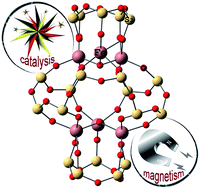A heterometallic (Fe6Na8) cage-like silsesquioxane: synthesis, structure, spin glass behavior and high catalytic activity†
Abstract
The exotic “Asian Lantern” heterometallic cage silsesquioxane [(PhSiO1.5)20(FeO1.5)6(NaO0.5)8(n-BuOH)9.6(C7H8)] (I) was obtained and characterized by X-ray diffraction, EXAFS, topological analyses and DFT calculation. The magnetic property investigations revealed that it shows an unusual spin glass-like behavior induced by a particular triangular arrangement of Fe(III) ions. Cyclohexane and other alkanes as well as benzene can be oxidized to the corresponding alkyl hydroperoxides and phenol, respectively, by hydrogen peroxide in air in the presence of catalytic amounts of complex I and nitric acid. The I-catalyzed reaction of cyclohexane, c-C6H12, with H216O2 in an atmosphere of 18O2 gave a mixture of labeled and non-labeled cyclohexyl hydroperoxides, c-C6H11–16O–16OH and c-C6H11–18O–18OH, respectively, with an 18O incorporation level of ca. 12%. Compound I also revealed high efficiency in the oxidative amidation of alcohols into amides: in the presence of complex I, only 500 ppm of iron was allowed to reach TON and TOF values of 1660 and 92 h−1.



 Please wait while we load your content...
Please wait while we load your content...